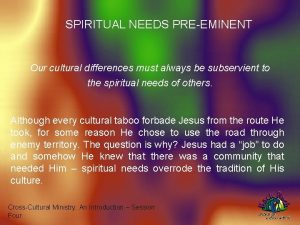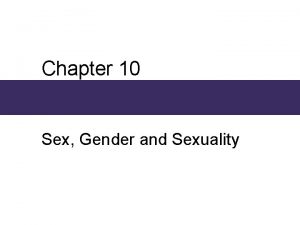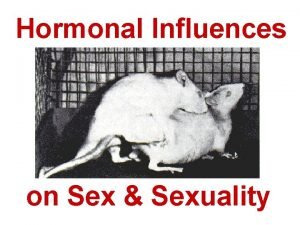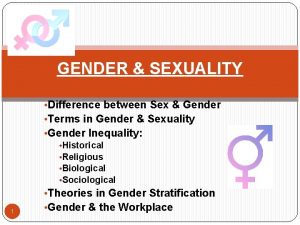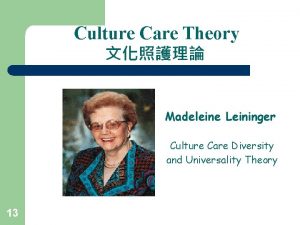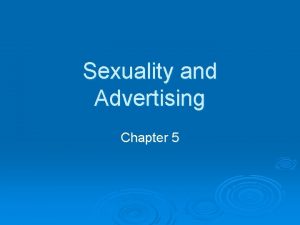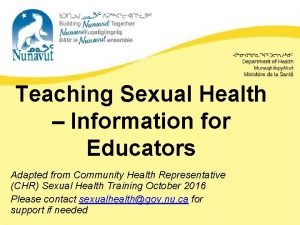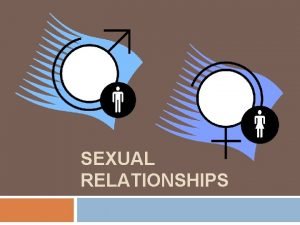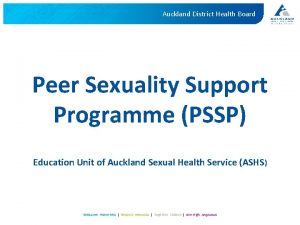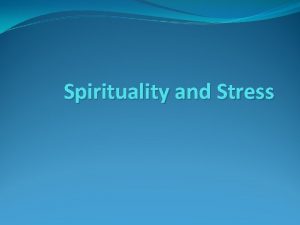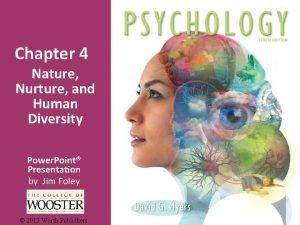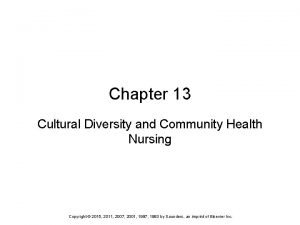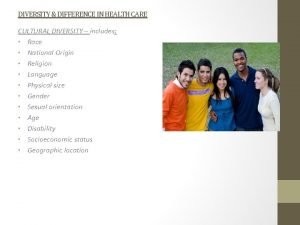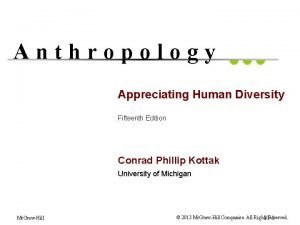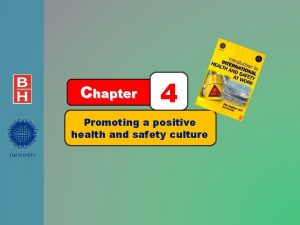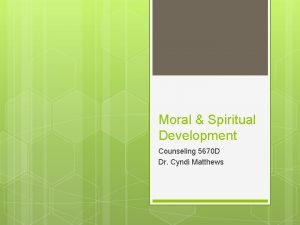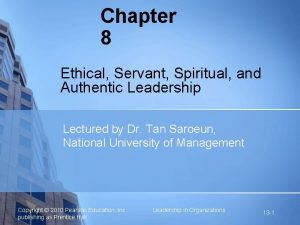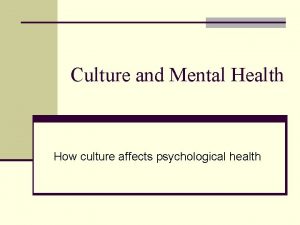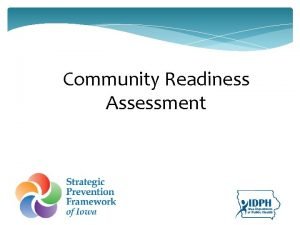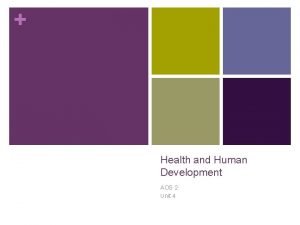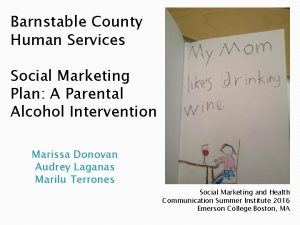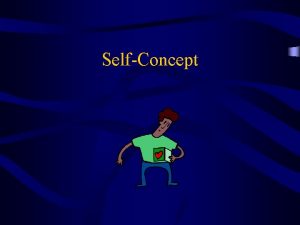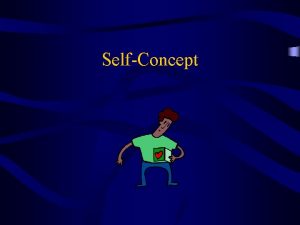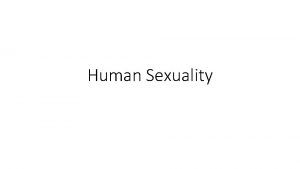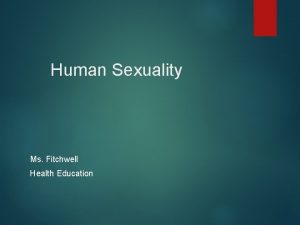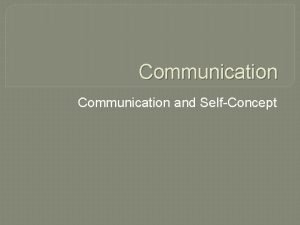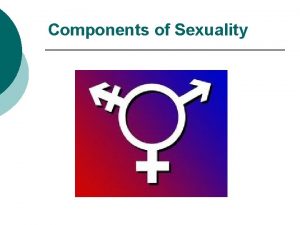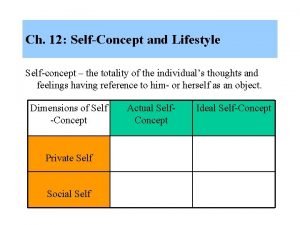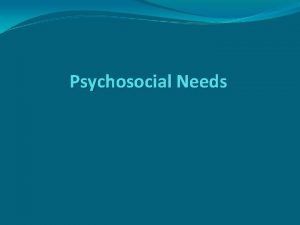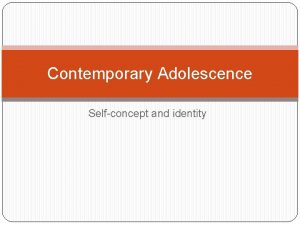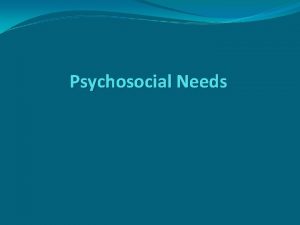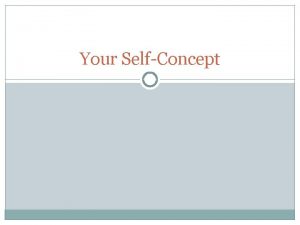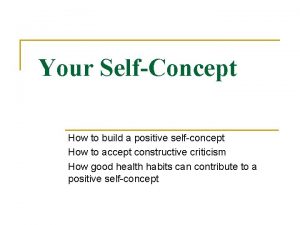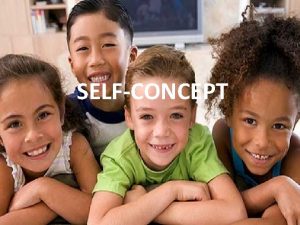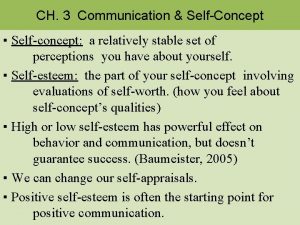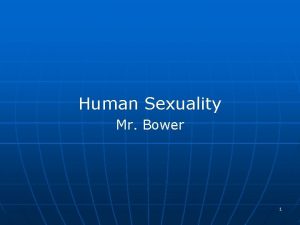Culture Diversity SelfConcept Human Sexuality and Spiritual Health













































































- Slides: 77

Culture & Diversity, Self-Concept, Human Sexuality, and Spiritual Health Fundamentals of Nursing NUR 1117 By: April Martin, BSN, RN

Culture & Diversity – Chapter 4 Class Objectives: �Describe basic components and concepts of culture �Identify how culture can affect healthcare �Explain the importance of cultural competence in nursing https: //www. youtube. com/watch? v=fqa. PMHbg 0 k. M

Class Objectives (cont. ) �Increasing the diversity of people with who nurses communicate effectively. �Enabling nurses to attend more accurately to the integrity of the patient as a socially and culturally connected person. �Preventing nurses from imposing, however unintentionally, their own culturally shaped assumptions and bias on patients and peers.

What is Culture? The values, beliefs, standards, language, thinking patterns, behavioral norms, communications styles, etc. shared by a group of people. It guides decisions and actions of a group through time. ______ controls behavior in deep and persisting ways. We have an obligation to be _____ and _____ to another’s belief system. Healthcare workers must be _________ and comfortable with those they serve. Healthcare workers should understand how their own _____ and _____ influence communication with patients, families, and co-workers.

Characteristics of Culture is: �Learned �Dynamic �Diverse �Ethnocentric �Relative �Observable in Rituals �Box 4 -1 on page 60

What is Ethnicity/Ethnic Identity? �A self-conscious, past-oriented shared identity related to social and cultural heritage: values, geographical space, racial characteristics. �Usually passes from generation to generation and members share common social and cultural heritage. Examples: People may define their ethnicity as Native American, African American, Korean, etc.

Important Terms � _____ A group of people within a society whose members have different ethnic, racial, national, religious, sexual, political, linguistic, or other characteristics that form the most of society. � _____ Takes biologic characteristics as the markers of separate social status. IMPORTANT TO KNOW: Ethnic group and race are often used interchangeably. (Ethnic takes on the social characteristics and race takes on the biologic characteristics). � _____ Uses skin color as the primary indicator for social value. Often implicated disparities in health outcomes and healthcare services.

More Terms: �_____ A way of life, customs, and ideas of a particular group of people within a society, which are different from the rest of the society. �_____ Preconceived and untested beliefs about people. Can be demeaning or idealizing (ex: Asians are stoic, people on welfare lazy, nurses are patient people) *Important for nurses to examine their own stereotypes that may be expressed in unconscious behavior that can demean people they are trying to help.

More Terms: �_____The ability to be open to learning about and accepting of different cultural groups. �_____ The recognition and acknowledgement that society is diverse. In addition to the dominant cultural, there exists many other cultures based around ethnicity, sexual orientation, geography, religion, gender, and class.

Cultural Competence �Patients have the right to receive care that is individualized and culturally acceptable. �Care should be built on the support and healing that cultural ties may provide. �Nurses increase quality and safety when they consider cultural influences on their own responses as well as those of the patient, family or community to health, disease, and illness. *Culture is an integral part of the knowledge and practice of nursing.

Nursing Implications for Culturally Competent Care Nurses should: � perform a cultural assessment and investigate a patients beliefs and practices � provide care that fits the valued life patterns of the patient � explain the purpose if physical closeness is required � consider variations in different groups when assessing patients � seek a trained interpreter if the patient speaks a different language

Common Strategies for improving patient-provider interaction: �Provide interpreter services �Recruit and retain minority staff �Provide training to increase cultural awareness, knowledge, and skills �Use community health workers �Incorporate culture-specific attitudes and values into health promotion tools �Treat patients as individuals �Include patient, family, and community members in health care decision making �Locate clinics in geographic areas that are easily accessible for certain populations

How to Use an Interpreter �Tell the patient about the role of the interpreter and matters such as confidentiality, boundaries and involvement with their care. �Ask questions one at a time and wait for patient’s response �Invite the patient to raise any concerns or ask questions �Speak to the patient about matters pertaining to them and not the interpreter �Maintain eye contact and keep your body towards the patient

How to Use an Interpreter (cont) �Make use of additional methods of communication (for example writing or drawing) �Check the patient’s understanding; medical jargon can be confusing �not solely rely on the interpreter �Respond to non-verbal cues instead of solely relying completely on the interpreter �Be aware of, and address, any patient distress/anxiety caused by the interpreter �Ask the patient if they are happy to have the same interpreter again �www. nursingtimes. net/equality

Self-Concept – Chapter 17 https: //www. youtube. com/watch? v=o. NC 9 cc 5 Zsy. U

Class Objectives: �Describe self and self-concept �Recognize patterns of self-concept that develop throughout the lifespan �Identify factors that can affect self and self-concept �Recognize ways in which nurses can assist patients in meeting self-concept needs

What is self-concept? �The mental image one has about oneself; what helps make each individual unique �Positive and negative self-assessments in the physical, emotional, intellectual, and functional dimensions that change over time �The frame of reference that influences how a person handles situations and relationships �Crucial to esteem and actualization

What are some factors that influence self-concept?

Characteristics of Self-Concept �Self-knowledge – “Who am I? ” �Self-expectation – “Who or what do I want to be? ” �Social self – How one sees him/her self in relation to social settings and situations? �Self-evaluation – “How well do I like myself? ”

Characteristics (cont) �Self-knowledge is the term used to describe the composite of all basic facts, qualities, traits, images and feelings one holds about oneself. (conscious of one’s abilities) �Self-expectations are the ideal self that one wants to be. �Self-evaluation is the conscious assessment of the self, leading to self-respect or selfworth.

Normal Self-Concept Patterns

Characteristics (cont) _____is an attitude about one’s physical attributes and characteristics, appearance, and performance. �Includes the conscious and unconscious disposition about one’s body �Includes sense of maleness or femaleness �These perceptions are not always accurate

10 Steps to Positive Body Image � Appreciate all that your body can do. � Write a top-ten positive list about self. � Remind yourself that “true beauty” is not simply skin deep. � Look at yourself as a whole person. � Surround yourself with positive people. � Overpower negative thoughts with positive ones. � Wear clothes that are comfortable and that make you feel good about your body. � Become a critical viewer of social and media messages. � Do something nice for yourself. � Use your time to do something helpful for others.

Characteristics of Self-Concept _____ is the judgement of personal performance compared with the self-ideal. (self-worth) �Derived from how people feel about themselves and from how others feel about them (can be positive or negative) �Develops in childhood and adolescence and becomes more stable in adulthood.

Characteristics of Self-Concept _________is a persistent, enduring way in which a person sees himself as a distinct individual separate from others �More of a self-described character trait than a role. Examples: I am a responsible person. ” “I am a winner. ” “I am strong. ” �One’s sense of identity can play into his/her self-esteem

Characteristics of Self-Concept �_____is defined as a person’s expected characteristic behavior in a social position. �An _______is given to a person without a choice. Examples: gender, ethnicity, age �An _______ is selected by a person. Examples: nurse, teacher, single, married �When a person identifies self as adequate in various roles, self-esteem rises.

Altered Self-Concept �_____may be characterized by poor personal hygiene, disregard for health maintenance activities, inappropriate exposure or concealment of body parts affected by disease, and lack of health-seeking behaviors. �_________ include feelings of depersonalization, hopelessness, helplessness, alienation, fear of rejection, anger, sadness, shame, guilt, inadequacy, worthlessness, and suspicion of others.

Altered Self-Concept (cont) �_________may be occur when there is a change in body image, problems with roles or identity, low self-esteem, or when a person is threatened. �____________ such as substance abuse (drugs, alcohol), sexual promiscuity, gambling, and overeating are some manifestations.

Assessment The nurse who assesses the patient’s selfconcept is better equipped to implement the nursing process �Focus on each aspect of self-concept; ask questions �Determine past coping mechanisms �Significant others may provide information about how the patient is handling illness �Ask client about his/her expectations after this event.

Nursing Diagnoses �Disturbed Body Image �Parental Role Conflict �Disturbed Personal Identity �Ineffective Role Performance �Chronic Low Self-Esteem �Situational Low Self-Esteem

Nursing Interventions �Nurse is a role model Can a nurse NEGATIVELY affect a client’s self-concept? �Form helping relationship �Meet physiological and psychological needs �Promote positive self-esteem �Encourage client to recognize and discuss thoughts and feelings

Human Sexuality – Chapter 41 https: //www. youtube. com/watch? v=a. I-Ojb 1 z. Op. Y

Class Objectives �Describe characteristics of normal sexuality and normal sexual patterns including lifespan considerations �Discuss factors that affect sexuality �Identify nursing interventions appropriate for altered sexual function

Human Sexuality �_____ includes the function of the sexual organs and the person’s perceptions of his or her own functioning, sexual expression, and preferences. �_____is a state of physical, emotional, mental, and social well-being in relation to sexuality

Human Sexuality �Sexuality changes as a person grows and develops �Each stage of development brings changes in sexual functioning and the role of sexuality in relationships. As a nurse you need to understand the structure and function of the reproductive systems, normal sexual patterns (sexual response) and lifespan consideration (menarche and menopause)

Characteristics of Normal Sexuality What is sexual orientation? What are the various forms of sexual orientation? �Heterosexual �Homosexual �Bisexual

Gender Identity and Roles Gender Identity is a person’s psychological identification as a man, woman, or something else �A _____ person is someone who appears as, may have had surgery for, or desires to be a member of the opposite sex. �A _____ man views himself as a woman trapped in a man’s body; the reverse is true for a female transsexual. �An _____ person is born with “ambiguous genitalia. ”

Factors Affecting Sexuality Sexual expression varies with individuals with no determined “normal” � Relationships � Cognition and Perception � Culture, Values, and Beliefs � Emotional state – depression � Self-Concept/Self-Esteem � Pregnancy � Knowledge/Misconceptions about sexuality � Experience (abuse, cultural taboos, fears)

Factors Affecting Sexuality (cont) �Environment (privacy) �Surgery (c-section, hysterectomy, mastectomy, ostomies, amputations) �Spinal Cord Injury �Chronic Illnesses �Medication ◦ Social Drugs – marijuana, cocaine, etc. ◦ Prescription Drugs – antihypertensive, antipsychotics, antidepressants, neurotransmitters, hormones

Altered Sexuality �Sexual Abuse �Inhibited Sexual Desire �Impotence �Ejaculatory Dysfunction �Orgasmic Dysfunction �Dyspareunia �Vaginismus

Discussing Sexual Issues �Sexuality is an important part of each person’s being, yet discussion and treatment is often avoided �Important to be able to discuss: ◦ Contraception ◦ Abortion ◦ STD’s – especially HPV (Gardisil Vaccine)

�Important…… ◦ Nurses need to explore their own discomfort discussing sexual issues and develop a plan to deal with it.

Sexuality and the Nursing Process �Assessment ◦ Discern if there is a problem ◦ Use an opening statement to put client at ease ◦ Decipher if there any contributing factors ◦ Ask direct questions ◦ Observe nonverbal behavior ◦ Evaluate information obtained through physical assessment and diagnostic/lab tests ◦ Identify normal pattern, risks, dysfunction ◦ Examine male and female genitalia

Nursing Diagnosis �Sexual Dysfunction �Ineffective Sexuality Patterns

Planning/Implementation �Planning � Involve the patient � Communicate the normalcy of feelings � Determine what the client needs (education, referral) and plan accordingly � Establish a trusting relationship with the patient �Implementation � Health promotion and education is the key for promoting good sexual health

Planning/Implementation (cont) �Acute Care - illness and surgery can be the stressors ◦ When patients express a sexual concern, initiate discussions, and educate appropriately �Restorative, Continuing Care, Home Health ◦ Do not assume the patient is not interested because he/she is elderly or has a poor prognosis ◦ Identify problems and help come up with solutions

Teaching Sessions �Testicular Self-Exams �Kegel Exercises �Breast Self-Exams �Contraception �STDs �Safe Sexual Practices


�How to do Kegel exercises ◦ Find the muscles you use to stop urinating. ◦ Squeeze these muscles for 3 seconds. Then relax for 3 seconds. Your stomach and thigh muscles should not tighten when you do this. ◦ Add 1 second each week until you are able to squeeze for 10 seconds each time. ◦ Repeat this exercise 10 to 15 times per session. Try to do this at least 3 times a day. ◦ Don't do Kegels while you urinate. Doing them during urination can hurt your bladder. ◦ Kegels work best when done on a regular schedule.

Breast Self-Exam Teaching Tool �DID YOU KNOW? �In 2016, an estimated 246, 660 new cases of invasive breast cancer are expected to be diagnosed in women in the U. S. , along with 61, 000 new cases of non-invasive breast cancer. �About 2, 600 new cases of invasive breast cancer are expected to be diagnosed in men in 2016. http: //www. healthywomen. org/sites/default/files/Shower. Card. pdf

Contraception Methods � http: //www. sexualityandu. ca/uploads/files/ref. Contraceptiv e. Comparative. Chart. Final. ENG 09. pdf

Who Gets the Gardisil Vaccine? �Females between the ages of 9 to 26 �Males between the ages of 11 to 21 �Preferably vaccine should be completed prior to patient becoming sexually active �Can be given even if suspected exposure to HPV �Does not cure or treat current HPV

What Gardasil Can Protect Against? � GARDASIL is an HPV vaccine that helps protect your child against 4 types of HPV. � In girls and young women ages 9 to 26, GARDASIL helps protect against 2 types of HPV that cause 70% of cervical cancer cases, and 2 more types that cause approximately 90% of genital warts cases � In boys and young men ages 9 to 26, GARDASIL helps protect against approximately 90% of genital warts cases � GARDASIL also helps protect girls and young women ages 9 to 26 against about 70% of vaginal cancer cases and up to 50% of vulvar cancer cases � In males and females ages 9 to 26, GARDASIL helps protect against about 80% of anal cancer cases

Spiritual Health – Chapter 42

Class Objectives �Distinguish the difference between religion and spirituality �Discuss normal spiritual function including characteristics of spirituality �Explain how spiritual beliefs affect healthcare �Identify ways to offer spiritual support to the patient

What is Spirituality? �_____ refers to a belief in a higher power, an awareness of life and its meaning, the centering of a person with purpose in life. It involves relationships with a higher being, with self, and with the world around the individual. Spirituality implies living with moral standards.

Spiritual Health (cont) �Helps people identify meaning and purpose of life, look beyond the present, and maintain personal relationships as well as relationship with a higher being or force. �Spiritual well-being can be thought of as an affirmation of life, reach harmony, and a connection with God, self, community, and the environment

Spirituality and Religion �The terms spirituality and religion are at times used interchangeably, but spirituality may or may not be related to religion and religious practices.

Characteristics of Spirituality �The major characteristics of spirituality include a sense of wholeness and harmony within one’s self, with others, and with God or a higher power as one defines it. �This does not mean that individuals are satisfied with life or have all the answers. �As life unfolds, there will be situations that cause anxiety, helplessness, hopelessness or confusion causing complex spiritual questions to be formed.

Holism �Humans are mind, body, and soul �Health and well-being exist when all are balanced and working in harmony �Holistic approach to nursing care recognizes the spiritual struggle as fundamental to health care �Nurses who support the spirituality of clients and their families are successful in helping patients achieve desirable health outcomes

Spiritual Need �Represents a normal expression of a person’s inner being that seeks meaning in all experiences as well as in a dynamic relationship. �Includes: trust, forgiveness, love, relatedness, faith, creativity, and hope, meaning and purpose, and grace

Spiritual Quest �Life can be viewed as a spiritual journey or quest. Not only to seek the answers to life’s philosophic questions but to seek a higher level of consciousness or a deeper awareness of spiritual life.

Spiritual Well-Being �A condition marked by an affirmation of life, peace, harmony, and a sense of interconnectedness with God, self, community, and environment that nurtures and celebrates wholeness. �There has been shown a connection between spiritual well-being and a heightened immune system.

What are the Normal Spiritual Patterns? �Atheist �Agnostic �Theism �Faith �Religion �Hope

Major World Religions �Roman Catholic – fasts and abstain from meat on some Holy Days; birth control and abortion are prohibited; believe in the “anointing of the sick” �Protestants – use alcohol and tobacco is forbidden by many denominations; Episcopalians may observe fasting and abstinence from meat on some days; birth control is a matter of choice and abortion is discouraged but there may be exceptions; believe in notifying of clergy, scripture reading and prayer

Major Religions (cont) �Orthodox Jews – Kosher foods; do not encourage birth control; abortion may be performed only to save the mother’s life; require special procedures for body after death �Islam – pork and alcohol are forbidden; contraception is permitted but abortion is forbidden; believe family should be with the dying to read the Koran; special procedures to care for body after death

Major Religions (cont) � Jehovah’s Witness – tobacco, alcohol, and caffeinated beverages are forbidden; birth control is a personal choice; no blood products � Buddhism – no alcohol or tobacco allowed; color white means death (uniform anxiety) � Table 42 -1 p. 1371 Know your patient and be familiar with beliefs regarding circumcision, birth control, autopsy/death rituals, and handling of the deceased.

Factors Affecting Spiritual Health �Altered spiritual function/spiritual crisis and grieving can cause questioning of life and its meaning �Things that can affect expression of spiritual needs include: ◦ Culture ◦ Gender and previous experience ◦ Illness or surgery ◦ Trauma ◦ Loss of a loved one or pregnancy

Factors Affecting Spiritual Health �Distress can occur when there is a conflict between a person’s beliefs and prescribed health regimens, or the inability to practice usual rituals. �Outcomes can be positive or negative depending on coping and support – may have new introspection and commitment to beliefs.

Nursing Diagnoses �Readiness for Enhanced Spiritual Well- Being �Spiritual Distress �Risk for Spiritual Distress �Decisional Conflict (specify) �Noncompliance (specify) �Impaired Religiosity �Moral Distress

Outcome Identification and Planning �Goals for patients with spiritual distress or spiritual alterations should focus on providing an environment that supports usual religious practices and beliefs ◦ The patient expresses a sense of connectedness with self, others, the arts, or a power greater than self. ◦ The patient expresses meaning and purpose of life.

Nursing Implications �Be aware of your own spirituality and spiritual well-being �Be knowledgeable – know concepts of spirituality and the patient’s faith and beliefs �Encourage the patient to speak of his/her perceptions about personal spirituality – Don’t just call the chaplain �Build a trusting relationship using therapeutic communication skills �Provide a supportive environment in respect of the patient’s own beliefs and practices

Nursing Implications (cont) �Do not attempt to change a patient’s faith. �May participate in prayer and meditation with patient if they wish and you are comfortable with it. �Respond to requests to see clergy or chaplain. �Dying patients and their families frequently need referrals

Quick Review � Culture & Diversity ◦ Characteristics ◦ Ethnic Identity ◦ Important Terms ◦ Competency ◦ Using an Interpreter � Self-Concept ◦ Factors ◦ Characteristics ◦ Normal Patterns ◦ Educating Positive Body Image ◦ Altered Self-Concept ◦ Assessing ◦ Nursing Interventions � Human Sexuality ◦ Sexual Orientation ◦ Gender Identity/Roles ◦ Factors ◦ Planning/Implementati on ◦ Teaching Sessions � Spiritual Health ◦ Spirituality/Religion ◦ Characteristics ◦ Needs ◦ Normal Spiritual Patterns ◦ Major Religions ◦ Factors ◦ Outcome/planning ◦ Nursing Implications

References Castaldi, P. A. (2007). Basic nursing: Essentials for practice (6 th ed. ). St. Louis, MI: Mosby Elsevier. � Craven, R. , Hirnle, C. , & Jensen, S. (2013). Fundamentals of nursing: Human health and function (7 th ed. ). Philadelphia, PA: Wolters Kluwer Health/Lippincott, Williams & Wilkins. � Delmar Cengage Learning (n. d. ). Chapter 43: Self-concept [Power. Point slides]. Retrieved from http: //www. delmarlearning. com/companions/content/076683 8366/students/ch 43/index. asp � National Eating Disorders Association. (n. d. ). 10 steps to positive body image. Retrieved from https: //www. nationaleatingdisorders. org/10 -steps-positivebody-image � National Women’s Health Resource Center. (n. d. ). Breast selfexamination. Retrieved from http: //www. healthywomen. org/sites/default/files/Shower. Card. pdf �

References � � � Robles, A. (2010, October 12). Self concept and self-esteem—arby [Video file]. Retrieved from https: //www. youtube. com/watch? v=o. NC 9 cc 5 Zsy. U sharris 61. (2010, November 28). Cultural competency in nursing [Video file]. Retrieved from https: //www. youtube. com/watch? v=fqa. PMHbg 0 k. M Society of Obstetricians and Gynaecologists of Canada. (2007). Choosing a contraceptive that’s right for u [Comparative Chart]. Retrieved from http: //www. sexualityandu. ca/uploads/files/ref. Contraceptive. Comparat ive. Chart. Final. ENG 09. pdf Robles, A. (2010, October 12). Self concept and self-esteem—arby [Video file]. Retrieved from https: //www. youtube. com/watch? v=o. NC 9 cc 5 Zsy. U Testicular Cancer Awareness Foundation. (2016). Monthly testicular self-exams. Retrieved from http: //www. testicularcancerawarenessfoundation. org/self-exam-howto/ World Science Festival. (2015, January, 29). The many faces of human sexuality [Video file]. Retrieved from https: //www. youtube. com/watch? v=a. I-Ojb 1 z. Op. Y

�Time for
 Chapter 8 human resources culture and diversity
Chapter 8 human resources culture and diversity Chapter 8 study guide human resources culture and diversity
Chapter 8 study guide human resources culture and diversity 1 corinthians 2 9-13
1 corinthians 2 9-13 It fulfills the spiritual needs of a culture.
It fulfills the spiritual needs of a culture. Pretest: growth, development, and sexuality
Pretest: growth, development, and sexuality Chapter 10 sex gender and sexuality
Chapter 10 sex gender and sexuality Sex
Sex Difference between sex and gender
Difference between sex and gender Why is genetic diversity important
Why is genetic diversity important Genetic diversity vs species diversity
Genetic diversity vs species diversity Madeleine leininger sunrise model
Madeleine leininger sunrise model Diversity and human needs and development
Diversity and human needs and development Sexuality in advertising
Sexuality in advertising What are the 4 strands of sexuality?
What are the 4 strands of sexuality? Circles of sexuality
Circles of sexuality Definition of sexuality
Definition of sexuality Definition of sexuality
Definition of sexuality Which illustrates an emotional aspect of teen sexuality?
Which illustrates an emotional aspect of teen sexuality? Peer sexuality support programme
Peer sexuality support programme Sexuality
Sexuality Sexuality spectrum
Sexuality spectrum Spiritual health definition
Spiritual health definition Unity in diversity in indian culture
Unity in diversity in indian culture Nature nurture and human diversity
Nature nurture and human diversity Nature nurture and human diversity
Nature nurture and human diversity Time space compression ap human geography
Time space compression ap human geography Batch culture vs continuous culture
Batch culture vs continuous culture Difference between american and indian culture
Difference between american and indian culture Stab culture and stroke culture
Stab culture and stroke culture Folk culture and popular culture venn diagram
Folk culture and popular culture venn diagram Chapter 4 folk and popular culture
Chapter 4 folk and popular culture Anaerobic media
Anaerobic media Folk culture and popular culture venn diagram
Folk culture and popular culture venn diagram Lawn culture method
Lawn culture method Lawn or carpet culture method
Lawn or carpet culture method Surface culture deep culture and esol
Surface culture deep culture and esol Culturological assessment
Culturological assessment Chapter 13 diversity and difference in health care
Chapter 13 diversity and difference in health care Cultural diversity a primer for the human services
Cultural diversity a primer for the human services Multilingual definition ap human geography
Multilingual definition ap human geography Anthropology appreciating human diversity
Anthropology appreciating human diversity Individual culture traits combine to form culture patterns.
Individual culture traits combine to form culture patterns. Batch culture vs continuous culture
Batch culture vs continuous culture Individualistic culture definition
Individualistic culture definition Subculture group
Subculture group Inert organizational culture
Inert organizational culture Quality culture changing hearts minds and attitudes
Quality culture changing hearts minds and attitudes Unit 3 ap human geography
Unit 3 ap human geography Promoting a positive health and safety culture
Promoting a positive health and safety culture Hhd study design
Hhd study design Health and social component 3
Health and social component 3 The intellectual and spiritual leaders
The intellectual and spiritual leaders Nepali mandir euless
Nepali mandir euless Moral/spiritual development
Moral/spiritual development Pituitary gland and pineal gland spiritual
Pituitary gland and pineal gland spiritual អភិសមាចា
អភិសមាចា Folk vs popular culture
Folk vs popular culture 8.3 human needs
8.3 human needs Chapter 8 human needs and human development
Chapter 8 human needs and human development Human and non human nouns
Human and non human nouns Influence of culture on mental health
Influence of culture on mental health Milwaukee county human services
Milwaukee county human services Human capital education and health in economic development
Human capital education and health in economic development Iowa department of health and human services
Iowa department of health and human services Stress health and human flourishing
Stress health and human flourishing Hhd unit 4 aos 2
Hhd unit 4 aos 2 The human body in health and disease chapter 2 answer key
The human body in health and disease chapter 2 answer key The human body in health and disease chapter 2 answer key
The human body in health and disease chapter 2 answer key Adenomalacia is the abnormal hardening of a gland.
Adenomalacia is the abnormal hardening of a gland. Ihss siskiyou county
Ihss siskiyou county Milwaukee county health and human services
Milwaukee county health and human services Maine department of health and human services
Maine department of health and human services Food choices and human health
Food choices and human health Barnstable county human services
Barnstable county human services Different between health education and health promotion
Different between health education and health promotion Chapter 3 health wellness and health disparities
Chapter 3 health wellness and health disparities Health propaganda definition
Health propaganda definition Chapter 1 lesson 2 what affects your health
Chapter 1 lesson 2 what affects your health



